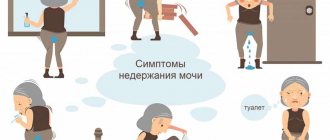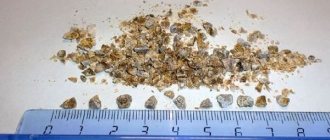Is it true that cystitis is caused by hypothermia and poor hygiene?
Normally, the mucous membrane of the bladder is covered with a protective layer. Hypothermia causes general stress in the body and a decrease in local immunity. As a result, the immune system does not fight off infections that have entered or were already in the bladder. The result is inflammation.
Risk factors for developing cystitis include:
- Anatomical and physical features of the structure of the female body. In women, the urethra is short and wide. In addition, it is close to the vagina and rectum, which are natural reservoirs of infection.
- Anomalies in the location of the external opening of the urethra.
- Frequent gynecological diseases. For example, inflammatory processes in the vagina, hormonal disorders, which can lead to vaginal dysbiosis and the proliferation of pathogenic microflora in it.
- Frequent change of sexual partners. This entails a risk of transmitting sexually transmitted infections.
- Contraceptives. For example, incorrectly selected condoms can cause irritation, and the lack of barrier methods of contraception allows infection to easily spread from a sexual partner.
Chronic cystitis, chronic urethritis. Symptoms
Unpleasant sensations in the area of the urethra, frequent urge to urinate, it is difficult to endure when you want to go to the toilet, there may be an increase in temperature in episodes at the time of exacerbation of cystitis, or a constant temperature slightly above 37⁰C - if this is a chronic process, there may be a violent exacerbation with a high temperature, admixture of blood in the urine, cloudy urine due to the presence of protein and elements of the mucous membrane that were rejected as a result of inflammation. In severe cases, there may be urinary retention due to swelling of the urethra. There are pains and stings when urinating.
In severe cases, the infection can ascend to the kidneys and cause inflammation of the renal pelvis - pyelonephritis, but this is usually rare
Diagnosis of cystitis
Diagnosis of the disease begins with a mandatory consultation with a urologist and a general urine test. Sometimes this is enough to start treatment. However, there are other situations. For example, if the picture of the disease is atypical, the doctor may suggest performing an ultrasound.
It is worth noting that acute cystitis can spread to the upper urinary tract and lead to pyelonephritis, that is, inflammation of the kidneys. With this disease, the tactics of examination and treatment change radically.
With recurrent cystitis, the range of necessary examinations expands. To understand the cause of chronic cystitis, your doctor may recommend the following tests:
- bacterial culture of urine (that is, identification of bacteria in urine, their number and type);
- screening for sexually transmitted infections;
- examination for viral infection.
Acute cystitis
Treatment of acute cystitis
Treatment of acute cystitis in women consists, first of all, of observing a “rest regime” for the bladder.
Bed rest is indicated only in severe cases. The first aid for acute cystitis is the use of novocaine, which allows you to get rid of detrusor spasms. The condition is alleviated by various drugs, relieving spastic contractions: papaverine, kellin, belladonna preparations. It is necessary to take antibiotics: sulfonamides (etazol, urosulfan) and nitrofuran drugs (furadonin, furazolidone), standard dosages. If no positive dynamics are observed, a urine culture and an antibiogram are performed, based on the study of which an antibiotic that is effective in a particular case is selected. In most cases, painful symptoms disappear on the first or second day of treatment for acute cystitis. The course of treatment lasts at least a week. To relieve pain, the patient may be offered local heat to the bladder area or warm sitz baths. Bladder lavage is not performed. Herbal medicine can be used as an adjuvant - herbal infusions with diuretic, tanning, antimicrobial and anti-inflammatory effects. After the symptoms disappear, physical therapy (electrophoresis, magnetic therapy, UHF, etc.) can be performed.
Treatment of acute cystitis requires mandatory adherence to a diet. The patient should avoid foods that irritate the bladder. You should not eat very salty foods, seasonings, marinades, or preserves. It is necessary to monitor regular bowel movements. The drinking regime should be enhanced - up to 2.5 liters of liquid per day. Basically, warm tea with milk and mineral water are recommended.
Treatment of acute cystitis, which is not accompanied by complications, is carried out on an outpatient basis; the patient must be under the supervision of a doctor; at the end of the course of treatment, a microscopic examination of urine is required.
If complications occur or in cases where drug therapy does not have an effect, hospitalization, further research and treatment in a hospital are necessary. After treatment of complicated cystitis, a bacteriological examination of urine is required.
Modern medicine suggests various methods for treating this disease during pregnancy, when taking antibiotics is undesirable, some of them are based on bladder instillations. The consequence of the lack of timely treatment of acute cystitis in pregnant women may be low fetal weight (less than 2.5 kg) or premature birth.
If the patient does not seek medical help when symptoms of acute cystitis occur, the symptoms may disappear on their own after a few days. But in such a situation, the risk of developing complications in the form of spread of infection to other organs increases. Infectious kidney diseases may occur (especially in patients in childhood or the elderly). It is also possible for the acute form of the disease to become chronic.
Self-medication is strictly contraindicated due to severe consequences. In this case, patients often mistake the cessation of symptoms of the disease for recovery, but this process is a sign of the development of chronic cystitis. The use of antibiotics without a doctor’s prescription (or unauthorized change in dosage or course duration) is prohibited, since all this leads to the gradual elimination of strains for which antibiotic therapy is not effective.
Causes of secondary cystitis
Due to the reason that led to the development of infection, inflammation of the bladder can be of an infectious nature and non-infectious: allergic, drug, radiation and toxic.
Primary cystitis occurs on its own, not accompanying any disease of the genital tract and not being its complication.
Secondary cystitis develops against the background of some pathology. This is possible when the mucous membrane of the bladder is scratched with the sharp edges of a stone during urolithiasis. The infection may be a complication of another disease, for example, chronic pyelonephritis or a bladder tumor.
How often does inflammation become chronic?
In most cases, the disease is well treated; in case of protracted course and lack of response to standard therapy, the pathogen and its sensitivity to drugs are determined. Therefore, a chronic course is possible only in every tenth person who has suffered acute inflammation.
Inflammation that occurs more than twice in six months or three times in a year is considered chronic. In most cases, a woman suffers from acute bladder infections several times throughout her life without becoming chronic.
Specialists at the Medicine 24/7 clinic will diagnose the pathology as soon as possible and help solve the clinical problem that worsens the quality of life.
What preventive measures will help avoid relapse of an acute disease?
When curing an acute disease, it is necessary to exclude all possible causes for the development of an exacerbation.
- Full treatment of sexually transmitted infections under the supervision of a gynecologist, and not according to the recommendations of comrades on social networks.
- Selection of birth control pills under the supervision of a specialist to maintain normal flora.
- Correction of prolapse of the vaginal walls, several treatment methods are offered today.
- Timely detection of urolithiasis and modification of diet to reduce stone formation.
- Cleanliness of the intimate area and discriminating attitude towards sexual partners, consultation with a specialist on hygienic procedures after sex. This includes mandatory urination and drinking plenty of fluids immediately after sexual intercourse.
At the Medicine 24/7 clinic, consultation with a doctor of any profile is available at any time; if clinically necessary, a consultation will be promptly convened, and you can get a competent opinion from a foreign specialist. Proper diagnosis and quick decision-making are facilitated by the clinic being provided with all the necessary equipment and expert-level tests.
Get a consultation with a doctor
Cystitis that occurs for the first time is considered acute, repeated inflammation is considered chronic, but this is not just repeated inflammation, but two acute inflammations in six months or three in a year. Inflammation of the bladder can be of an infectious nature or non-infectious: allergic, drug - often during chemotherapy, radiation, toxic - during poisoning.
Clinical observation No. 2
Patient M., 34 years old. Complaints of periodically occurring intense pain and pain in the urethra during urination, frequent urge to urinate, blood in the urine, nagging pain in the lower abdomen, turbidity and unpleasant odor of urine. At the time of examination, there were no active complaints; she noted moderate discomfort in the vestibule of the vagina outside of urination, which intensifies at the end and after miction.
Such episodes occur on average once every 2 months. last 4 years. Links the exacerbation to sexual intercourse with a spouse without the use of barrier methods of contraception after a period of forced sexual abstinence (due to the spouse's shift work).
I complained to a urologist. A general urine test was carried out, where an elevated level of leukocytes was determined, and a diagnosis of “acute cystitis” was established. Treatment with oral and injectable antibacterial drugs was recommended: protected aminopenicillins, third generation cephalosporins, fosfomycin, nitrofurantoin, furazidine. This therapy led to the disappearance of symptoms for a short period without the formation of persistent periods of remission.
Taking into account the peculiarities of the patient’s medical history, the frequency of acute dysuria, and confirmed leukocyte-uria in each episode, the attending physician made a preliminary diagnosis of “recurrent cystitis.”
According to the federal clinical recommendations of the Ministry of Health of Russia “Bacterial cystitis”, an examination was carried out in the following volume: laboratory examination of urine (general urine analysis, Nechiporenko urine analysis) - without signs of inflammatory changes; bacteriological examination of urine - total microbial number less than 102 CFU/ml. According to uroflowmetry, no signs of urinary disturbance were detected; the volume of residual urine was within normal limits.
When conducting a bacteriological study of vaginal discharge, scrapings from the vagina using the real-time PCR method "Femoflor 16", signs of bacterial vaginosis were revealed with a decrease in the concentration of lactobacilli, an increase in the number of anaerobic microorganisms ( Gardnerella vaginalis
more than 106 and
Enterobacteriaceae
105). During an additional examination, a gynecologist diagnosed “bacterial vaginosis” and carried out treatment aimed at normalizing the vaginal microflora. As a result of the treatment, the symptoms of discomfort in the vestibule of the vagina outside of urination disappeared.
According to the results obtained, at the time of the examination, no signs of an active infectious-inflammatory disease were detected in the organs of the urinary system. The main direction of patient management was the selection of an adequate anti-relapse regimen for the prevention of recurrent lower urinary tract infections.
General recommendations are given: drinking large amounts of fluid (more than 1.5 l/day), forced urination immediately after sexual intercourse, refusal to use spermicides and the diaphragm as methods of contraception, careful proper toileting of the external genitalia, limiting sexual contacts for the period of pre-examination and treatment by a gynecologist. Immunoactive prophylaxis with the drug OM-89 for 3 months was chosen as a drug regimen for anti-relapse therapy.
A definite recent trend has been the use of non-antimicrobial agents for the prevention of recurrent infections of the urinary system. In this case, Uronext was recommended in the regimen of taking 1 sachet within 6 hours after sexual intercourse.
Clinical observation by a urologist and gynecologist was carried out for 5 months. During the observation period, no relapses of acute cystitis were detected upon resumption of sexual intercourse with the spouse in the previous mode of activity.
Recently, due to the growing problem of antibiotic resistance of uropathogens to the main classes of antibiotics used, the use of long-term antimicrobial prophylaxis regimens has been sharply limited. In the example of this patient, the antibacterial load was significant - up to 6 courses per year for 4 years in a row. This factor is currently considered as a predictor of worsening intestinal and vaginal dysbiosis, which only increases the risk of another relapse of acute cystitis [18].
A feature of the presented observation of recurrent UTI was the connection with sexual intercourse after a period of abstinence. This circumstance suggested the choice of postcoital prophylaxis as the most preferable. The use of antibacterial drugs was undesirable.
In patients with recurrent UTIs, the use of Uronext helps to increase the relapse-free period. D-mannose and Cran-Max directly affect the main uropathogen - Escherichia coli ( E. coli
), preventing it from attaching to the urothelium and triggering an inflammatory reaction.
The anti-adhesive effect of D-mannose (blocking type 1 fimbriae) in cystitis and other UTIs is effectively complemented by cranberry proanthocyanins, since E. coli
have P-fimbriae (37.2%) and type 1 fimbriae (62.8%) [19]. Vitamin D3 is necessary to maintain an adequate immune response to the uropathogen. It has been shown that the active components of the dietary supplement Uronext can help reduce the frequency of exacerbations of cystitis by 4 times [20].
What symptoms indicate an exacerbation of cystitis?
Exacerbation of the inflammatory process is accompanied by the same symptoms as acute cystitis. Signs of the pathological process that led to chronicity of the disease may also play a special role. [11, 16]
During exacerbation of chronic cystitis, patients usually complain of frequent and painful urination. The pain may be intermittent or constant. It may intensify with urination, especially at the end of the act. Typically, discomfort is localized in the suprapubic region or deep in the pelvis. But such symptoms do not always indicate the presence of cystitis. It often accompanies diseases of the female reproductive system. [11, 16]
Symptoms of interstitial cystitis
According to Messing, interstitial cystitis can be described in one sentence as a triad of the following clinical signs:
- the presence of irritating symptoms from the lower urinary tract;
- characteristic cystoscopic image;
- lack of objectively identified reasons.
One of the characteristic clinical features of this disease is the sudden onset of the disease, spontaneous remissions, lasting on average about 8 months. The disease quickly reaches a certain level of severity of illness, constant for a given patient, at which it stabilizes for a long time. Worsening of symptoms is very rare.
Patients report frequent urinary tract infections in childhood (10 times more often than controls).
Hemorrhagic, interstitial and other types of cystitis
Based on the nature of damage to the bladder wall, the following morphological forms of the disease are distinguished:
- Catarrhal - with inflammatory edema of the wall, the most common form.
- Hemorrhagic - with hemorrhages in the inflamed wall, but the urine in this case is not bloody, but pinkish from red blood cells sweating through the vascular wall;
- Fibrinous-ulcerative - against the background of edema, ulcers of different sizes appear with undermined edges and covered with fibrin threads; the disease is severe with a pronounced general reaction.
- Gangrenous - with the collapse of the bladder wall and severe manifestations of intoxication: fever, headaches, vomiting and even changes in consciousness.
- Interstitial - it just hurts without obvious signs of infection, but inflammation in the wall of the bladder leads to its shrinkage, which is why the volume of the organ decreases, leading to worsening symptoms of cystitis.
In most cases of primary disease, it is very difficult to make a morphological diagnosis; as a rule, it is not clinical symptoms that help determine it, but endoscopic examination of the bladder - cystoscopy.
What can cystitis be?
An independent disease that occurs against the background of health and the absence of any anomalies that impede the normal outflow of urine is primary cystitis. Secondary cystitis occurs when the passage of urine through the urinary tract is impaired, which creates conditions for the penetration and proliferation of microorganisms. Such obstacles include bladder stones and tumors, displacement and deformation of the urethra by the prolapsed vaginal wall.
The chronic form occurs with episodic exacerbations, slightly less severe than the first inflammation of the bladder in life. In the intervals between exacerbations, a completely normal existence without signs of disease is possible.
What can a patient do for himself?
- At the first symptoms of the disease, avoid spicy and salty foods, which irritate the already inflamed mucous membrane of the bladder. This can be considered the beginning of treatment.
- Drinking plenty of fluids is at the second stage, when dysuria decreases, which will help flush out microorganisms and toxins.
- Start taking herbal medicines, even if these are only auxiliary means that do not affect the cause - the microflora, but they “soften” the composition of urine.
- If necessary, pain is relieved with analgesics.
Those who suffer from regular bladder inflammation know which pills can help. A characteristic sign of cystitis is a rapid reaction to antibiotics, and self-medication can also help, but it will certainly lead to a chronic process.
Clinical observation No. 1
Patient B., 32 years old. She complained of burning and cutting in the urethra during urination, frequent urgent urge to urinate, up to 3 episodes of urination during night sleep, moderate discomfort in the suprapubic area, temperature rise to 37.2 °C.
When collecting anamnesis, it was found that the symptoms of dysuria arose 3 days ago, their intensity increased over the next 24 hours. The urological anamnesis is not burdened. No hypothermia factor was identified; there was no sexual contact for 5 days before the development of symptoms of the disease. The patient was in contact with a patient with COVID-19 (sick husband).
Taking into account the peculiarity of the complaints and the speed of development of the pathological process, the doctor made a preliminary diagnosis of “acute cystitis”. According to the federal clinical recommendations of the Ministry of Health of Russia “Bacterial cystitis”, an examination was carried out: the score on the Acute Cystitis Symptoms Questionnaire (ACSS) was 15 points, including the severity of typical symptoms of acute cystitis - 6 points; Urinalysis (test strip): nitrite test and leukocyte esterase test - negative, microhematuria.
The results obtained excluded the diagnosis of acute bacterial cystitis and required additional examination as planned, including: ultrasound of the bladder, ultrasound of the kidneys, urethrocystoscopy, determination of SARS-CoV-2 coronavirus RNA in the discharge from the mucous membrane of the oropharynx and nasopharynx using PCR.
For the period of further examination, it is recommended to take the dietary supplement (BAA) Uronext (NPO Petrovax Pharm LLC) in the dosage regimen of 1 sachet 1 time per day for 7 days.
As a result of further examination, stones of the bladder and upper urinary tract were excluded according to ultrasound of the kidneys and bladder; According to urethrocystoscopy, signs of epithelial bladder cancer were excluded, hyperemia and swelling of the mucous membrane of the bladder in the area of the neck and triangle of Lieto were revealed. The test for SARS-CoV-2 is positive.
As a result, a diagnosis was made: COVID-19, a positive test result for the virus. Acute viral cystitis.
Treatment with the Uronext dietary supplement, started as monotherapy, contributed to an improvement in the condition due to a significant reduction in burning and cutting in the urethra during urination. Against the background of additional treatment for COVID-19, the patient noted the disappearance of urgent, frequent urge to urinate.
With the development of the COVID-19 pandemic in the world, descriptions of clinical observations began to appear, characterized by an increase in the frequency of urination, urgent urge to micturate, pain and discomfort when urinating in patients with COVID-19 [15]. At the same time, laboratory signs of an acute inflammatory process localized in the mucous membrane of the bladder - leukocyturia and bacteriuria - were not detected. Patients were diagnosed with viral cystitis associated with COVID-19.
It is assumed that against the background of a systemic inflammatory response, the concentration of inflammatory cytokines increases, which are released into the urine or secreted on the bladder mucosa. Researchers consider cystitis associated with COVID-19 as a manifestation of a long-term systemic inflammatory response of the body, in particular from the bladder [16].
Uronext is a dietary supplement consisting of three active components in an optimal dosage: D-mannose 2000 mg (the effectiveness of this dose was confirmed in randomized clinical trials with daily administration for the prevention of UTIs) [17], Cran-Max 500 mg (equivalent to 36 mg of proanthocyanidins) - a patented North American cranberry extract with increased effectiveness due to a patented form of release of cranberry molecules, which prevents the destruction of active components in the acidic environment of the stomach and allows for a 2-fold increase in bioavailability, as well as vitamin D3 1 mcg.
Cran-Max and D-mannose have anti-inflammatory and diuretic effects. Due to these effects, Uronext alleviates symptoms and accelerates recovery, which makes it possible to use it for acute cystitis and recommend it for the prevention of UTIs. Uronext has a good safety profile and can be recommended for pregnant women and people with diabetes.








